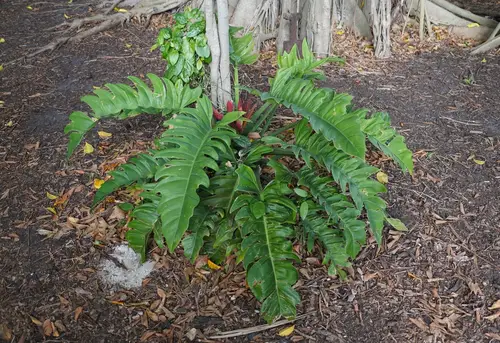The Philo Jungle Boogie is a tropical plant that is also known as, Philodendron Henderson’s Pride, Tiger Tooth, and Philodendron Narrow. It belongs to the Araceae family of perennials, is loved for its distinctive and lovely leaves.
Its dark green leaves are long and thin with serrated edges. When they mature, the leaves look like a chainsaw.
The Philo Jungle Boogie plant requires bright, indirect light and well-draining soil to thrive, making it a great choice for indoor gardening.
See similar posts:
- Philo Pedatum Plant, Grow & Care Guide 2022
- Philodendron Mamei Silver Cloud Plant, Grow & Care Guide 2022
- Subhastatum Philodendron Plant, Grow & Care Guide 2022
The hip name “Jungle Boogie” is thought to have been given because of the plant’s zigzag growth pattern, which undoubtedly contributes to its exoticness. It appears to be dancing back and forth as its vines lengthen. Want to know more about this gorgeous plant? We’ve got you covered!
What is Philo Jungle Boogie Plant?
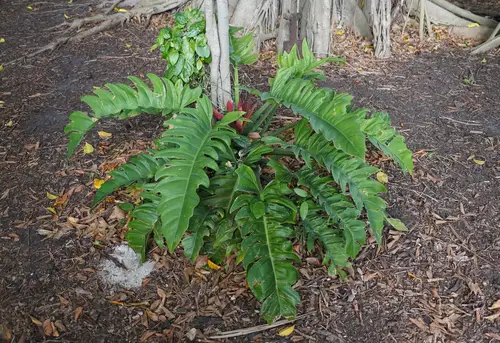
The Philo Jungle Boogie is a strong and resilient plant that is one of the easiest philodendrons to grow. With its delightful foliage, it would indeed be a wonderful addition to your plant collection. It is native to the rainforests of Mexico, Central, and South America, and the Caribbean.
The Philo Jungle Boogie needs to be watered regularly. Allow its soil to dry up between waterings. It thrives on soil that drains well, so choose a pot with a good drainage system. Healthy soil includes many organic materials, such as coco coir, and drainage-enhancing materials like perlite or vermiculite.
When the Philodendron Jungle Boogie doubles in size, you’ll know it’s time to repot it. Or you can do it once a year. You shouldn’t need to use fertilizer as long as you replenish your potting soil annually because it already has all the nutrients your plant needs.
The dormant period for Philo Jungle Boogie does not follow a conventional pattern. Make sure they are receiving enough sunlight and water if you see a significant slowdown in their growth.
Origin and Classification
The Philo Jungle Boogie is a member Araceae family as a Philodendron genus. It is originally from the tropical jungles of Mexico, Central and South America.
It is thought to be a hybrid that resulted from a mix between the Philodendron Tortum and the Philodendron Wendlandii. Because of their love of organically rich moist soil and warm conditions, these are commonly found in rain forests, swamps, and along riverbanks.
Features of Philo Jungle Boogie Plant
The Philo Jungle Boogie is a gorgeous tropical plant that has long, striking, saw-toothed leaves. Even its flowers are such a beauty. A lovely pink spathe and a white spadix blossom from them.
1. Height
It can reach a height of 3 feet and a width of 2 feet. The growth pattern resembles that of a bush or shrub. Although you can make the Philo Jungle Boogie climb, it is a terrible climber on its own.
2. Flowers
Philo Jungle Boogie plants that are still young won’t bloom or flower. But mature plants can blossom frequently. Specific conditions can cause the Philo Jungle Boogie to flower five times per year. A lovely pink spathe and a white spadix will develop from its center. The blossom can grow as long as 3 inches.
3. Leaves
With its long, narrow, zig-zag green leaves that give a lovely touch of the tropics, the Philo Jungle Boogie is definitely a plant that could be used for interior decorating. They are deep green in color, in a rosette formation, making the plant a showstopper in your house or garden.
4. Toxicity

This plant may seem captivating but if you have young children and pets, be sure to keep them away as the Philo Jungle Boogie is poisonous to both humans and animals. Common symptoms of ingestion are swelling of the tongue, throat, and lips, vomiting, and diarrhea. Take extra care as you handle it, especially while repotting or propagating it.
5. Dormancy
The Philo Jungle Boogie does not follow a typical dormancy pattern. If you observed that its growth has slowed significantly, check that it has enough sunlight and water to flourish.
Basic Care of Philo Jungle Boogie Plant
The Philo Jungle Boogie is a relatively easy, fuss-free plant to take care of, making it a popular choice among plant enthusiasts. The three most crucial aspects of excellent care are temperature, lighting, and watering.
Allow the plant to receive a modest amount of direct sunlight each day. In the spring and summer, you should water the plant at least once a week. Before you water it once again, let the topsoil dry. For optimum growth, maintain a steady and warm temperature.
Your plant can perish in freezing temperatures. The Philo Jungle Boogie has few issues, though, and even tolerates neglect. So don’t fear, we have a lot of useful tips here.
1. Size and Growth
When cultivated indoors, the Philo Jungle Boogie can reach a height of 2-3 feet. It grows up to two feet wide, and flourishes during the spring and summer seasons. Moreover, it grows quickly.
2. Requirements
The Philo Jungle Boogie requires a lot of bright indirect, sunlight all day long. No more than three hours should be spent each day under direct sunlight. The leaves will scorch under excessive sunlight. To get the ideal amount of sunlight, situate the plant in an east or north-facing window.
But it can also be positioned near a south or west-facing window. The distance from the window should be between three and six feet. If it receives insufficient sunlight, the stems and leaves would develop at a slower rate than usual. The stems would also be leggy.
3. Water Requirements
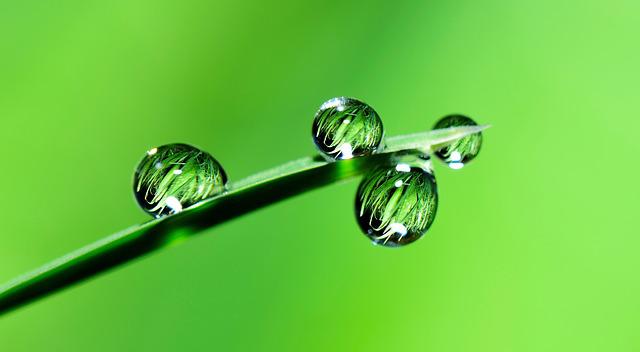
Depending on the season and weather, watering frequency varies. In the spring and summer, the plant must be watered once or twice a week. You might only need to water less than once a week during the winter.
Before watering your Philo Jungle Boogie again, let the topsoil dry out first. You’ll know you need to water when the top 2 inches of soil is dry. Allow the water to drain out of the pot, as excessive watering can cause root disease.
You might want to check out and download this app, to help you take care of your plant with certainty, as it can predict the water requirements of any plant in any environment and changing weather situations.
4. Soil Requirements
As the soil from this plant’s origin is loose, the best kind of soil for the Philo Jungle Boogie should also be loose. The soil should have good water retention and drainage at the same time. It thrives in soil with high organic content, such as coco coir, perlite, and vermiculite, for good aeration and drainage.
The Philo Jungle Boogie likes the soil to be slightly acidic, with a pH range of between 5.5 and 7.5. Add sulfur or aluminum sulfate if you believe the pH is too high. On the other hand, if it’s too low, add baking soda, wood ash or dolomitic lime.
5. Temperature and Humidity
The Philo Jungle Boogie prefers warm conditions, and it may flourish in a temperature range of 65 to 75 degrees Fahrenheit. Keep it away from windows and other openings that allow cold air to enter since it prefers stable temperatures. Keep it away from vents and other heat sources as well, as they could dry the air.
High humidity is good for your plant, about 70% or higher. You may place the plant in humid rooms, such as the kitchen, laundry room, or bathroom, to ensure high humidity.
Spritzing with water, especially if it’s in a dry place, might be a good way to keep the humidity level good for your plant. You may also look into purchasing a humidifier.
6. Pest and Disease Resistance
Spider mites can harm your Philo Jungle Boogie, so it’s important to keep an eye out for any symptoms of these pests. To tell whether you have spider mites, look for webbing on the underside of leaves and black patches or stippling on the foliage. Use an insecticidal spray that you may get at your neighborhood garden center to treat your plants.
7. Fertilizing
The soil you use will determine how much fertilizer to apply. If you use regular soil, fertilize once a month in the summer and spring. You don’t need to fertilize if you repot your plants every year or if your soil has worm castings. Regular liquid fertilizer would be good. You should water your Philo Jungle Boogie first, then dilute and add the solution.
8. Potting and Repotting
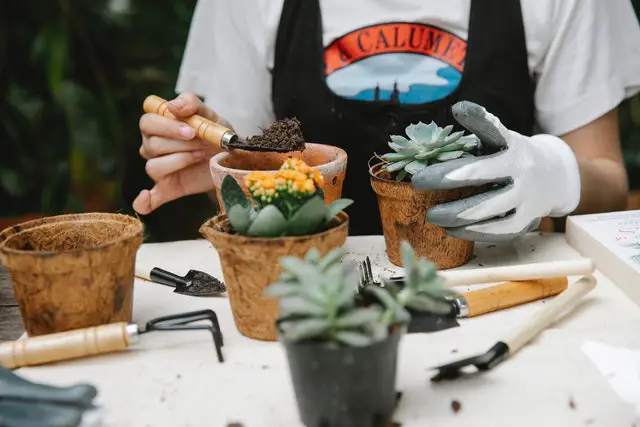
Many gardeners opt for plastic, terracotta, or clay containers. A large pot would be preferable for most plants. A good drainage system is also necessary to prevent root rot. You would need to repot it once a year or when you notice that it has doubled in size.
If you see this, remove the plant from its container with care, being mindful not to disturb the main root ball. Put the plant in a larger pot. When roots are put in the same substrate they are accustomed to, they adapt more quickly.
9. Pruning Requirements
Remove any leaves that are yellow or brown because attempting to save a dying leaf will only use up the energy of your precious plant. The Philo Jungle Boogie is a tough and resilient plant, so usually, you would just need to remove one leaf per year.
But perhaps you can’t wait for your plant to grow new leaves. If that’s the case, you can cut back the stem to promote new growing sites. You can then propagate the cuttings.
How to Propagate the Philo Jungle Boogie.
Stem cuttings are the most effective method of propagating the Philo Jungle Boogie. It is best to propagate it from spring to summer, which is the growing season. This is to ensure that it recovers more easily. You may choose between soil propagation and water propagation.
Soil Propagation
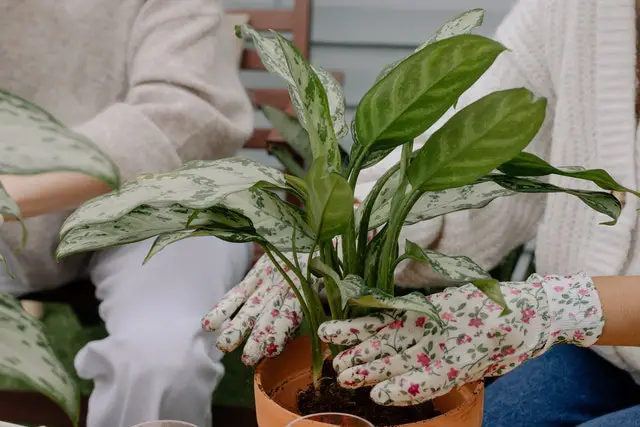
Step 1
Use clean shears to cut a healthy piece of the plant. A cutting needs a few leaves and nodes, and it must be at least 3” long.
Step 2
Plant the cutting so that moist soil covers the Pinch the dirt off the stem. Root development may be harmed by excessive movement.
Step 3
Put your container close to a window that receives plenty of indirect light.
Step 4
Keep the soil moist but not too wet.
Step 5
Wait and observe. In around two to three weeks, new roots should appear.
Water Propagation
Step 1
Start with a cutting that is a few inches long and has at least one node, preferably two or more.
Step 2
Put your cutting in a water-filled cup or container. We advise using clear glass so you can keep an eye on the growth of the roots.
Step 3
Put your fresh cutting in a location with good indirect lighting and consider placing a fan nearby to help with the airflow.
Step 4
To prevent infections, you should change your water every 4-5 days (maximum).
Step 5
After two weeks in the water, assess your plant’s progress. If the roots are about an inch or longer, transplant the cutting into a sterile potting mix.
Step 6
Wait until your plant has had a chance to stabilize, before adding any treatments or fertilizer. It’s typical for your new plant to appear wilted at first while its roots become accustomed to the soil.
Common Problems Caring for Philo Jungle Boogie
Congratulations! You have propagated your Philo Jungle Boogie successfully. You should now look out for some common problems in caring for this lovely plant.
1. Brown Leaf Tips
Your Philo Jungle Boogie leaves’ browning tips could be caused by a variety of factors, such as lack of humidity, too much light, heavy tap water, or too much fertilizer.
2. Low-hanging Leaves
If a Philo Jungle Boogie’s leaves are drooping, it means they are thirsty. Watering your plant generally brings it back to life in this situation. You may also increase humidity.
3. Yellow Leaves
The leaves can turn yellow for a variety of reasons, such as not receiving enough sunlight and too much or too little water. To foster new growth and stop the spread of deterioration, yellow leaves should be removed, using a clean, sharp pair of shears.
4. Root Rot

Excessive watering can cause root rot, which can kill your plant. To prevent this from happening, give your plant a quick-draining, well-aerated soil mix. Choose a pot with adequate drainage. Make sure that the soil is already dry in between waterings.
To check for moisture, poke your finger into the soil. Keep these in mind as it is difficult to stop rot once it has begun. If it already did, the best course of action is to totally cut off the plant’s root system and restart it, much as you would when propagating.
Outro
The impressive foliage of the Philo Jungle Boogie makes it a lovely adornment for your home, exuding an exotic jungle atmosphere. It is generally easy to cultivate, so you won’t have a lot of problems growing it. Just follow our tips here and you’re good to go!
Frequently Asked Questions
Are Philo Jungle Boogie rare?
Yes, they are incredibly rare! It is the perfect plant if you want to go for the exotic jungle vibes in your home. You’ll love being able to tell anyone that visits about his rare and beautiful plant that you have in your home.
How big does a Philo Jungle Boogie get?
The Philo Jungle Boogie grows to about 2-3 feet tall and 10 inches wide as a houseplant. This makes it a perfect size for a houseplant and it’ll look great wherever it is in your home.
Is the Philo Jungle Boogie the same as Ring of Fire?
The primary difference is in the plants’ coloration. The Philo Jungle Boogie is plain green. On the other hand, the Ring of Fire has pretty patches of yellow, orange, and red.

Hey, I’m Lisa and I’ve been an avid gardener for over 30 years. I love writing, talking and living in the garden! Feel free to connect with me on my socials below

